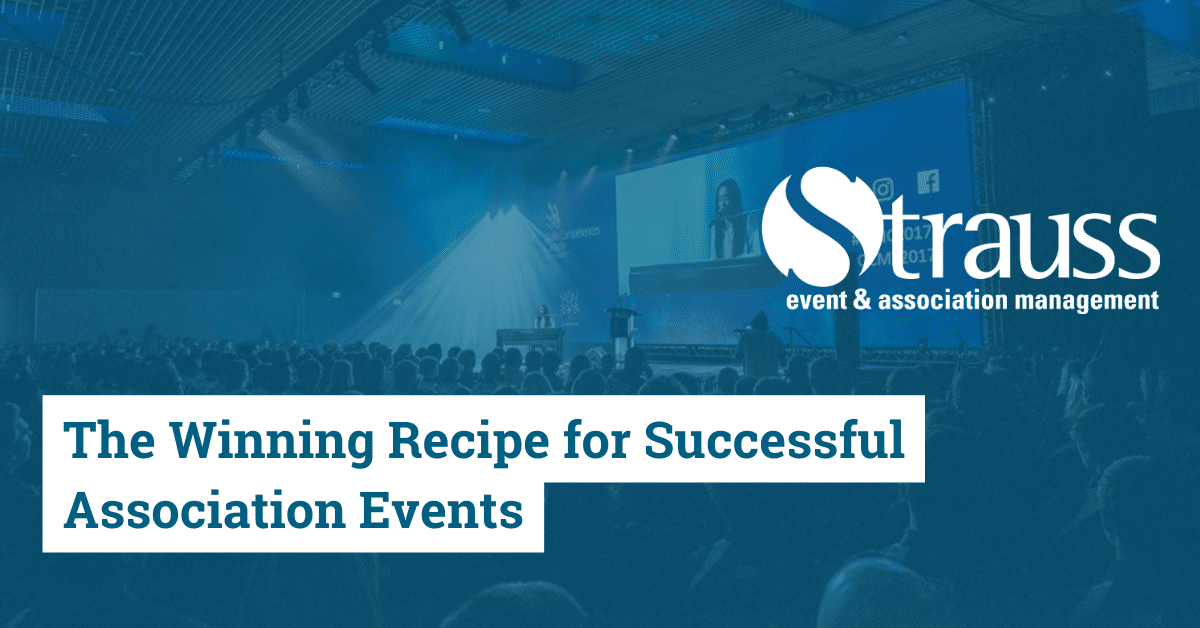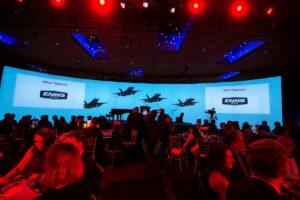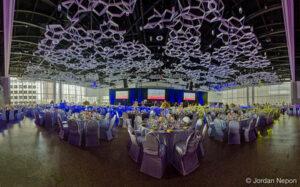A successful association event begins with a solid recipe that passed the test of people and time but is tweaked based on innovation, creativity, and past learning. Planning an event involves layers upon layers of details. There is a lot to keep track of, from planning to onsite management. Creating a solid plan for your next event takes time, to avoid rushed marketing activities leading to poor attendance and financial returns.
Events are an effective way to create a sense of community, build a common vision, boost brand awareness, and drive sales through shared experiences, networking, and fun that everyone remembers.
A TRIED and TRUE RECIPE for PLANNING SUCCESSFUL ASSOCIATION EVENTS
Ingredients:
- Event Goals
- Target Audience
- Date Selection
- Critical Path
- Budget
- Location and Venue
- Team
- Event Marketing
- Food and Beverage Selections
- Flavour
- Onsite Management
- Grow Your Event
Preparation Method:
Equal Parts Event Goals, Target Audience, Date Selection, and Critical Path
Determine event goals by identifying the purpose for your association event by asking what are we trying to achieve?
Identify your target audience. Ask questions like who is our preferred audience and their demographic? Why would they choose our event? Identifying a niche in your event will draw a specific crowd and help your event stand out from the others.
Suitable date selection helps your event stand out, resulting in increased attendance. Avoid conflicts with other conferences in your target industry, school breaks, public and religious holidays.
A critical path is a useful tool for managing tasks, time, and expectations. It also serves as an excellent reporting tool. Begin with the end in mind and work backwards! Break down all event tasks into small, manageable pieces and include as many details and dates as possible to avoid tasks falling through the cracks. Assign each element to the individual with the aligned skill set and note their accountability for completing assigned tasks.
The Budget Slightly Beaten.
Accurate estimates and disciplined spending will keep your budget on track. To establish your budget, consider how to pay for everything, including:
- Venue rental and insurance (if applicable).
- Food and beverage: don’t forget this is a variable expense dictated by attendance numbers.
- Entertainment, guest speakers or presenters; factor in travel, accommodations, per diems and other consumables.
- Décor
- Staff and Board Members’ travel expenses and accommodations.
- Marketing costs for traditional and social media, website advertising, signage, and print materials.
- Additional hardware, software, and AV needs.
Fresh Location and Venue
Place the above ingredients in a great space. Start by selecting a great city and a great venue to host your event. Use referrals from colleagues, local trade publications, Convention Visitor Bureaus, and national hotel experts to build a shortlist of locations and venues, then tour venues on your list. Prepare a list of questions to ask vendors you meet. Always ask about concessions such as complimentary rooms, upgrades, Wi-Fi, commissionable rates, easels, discounted or free parking, and more. Contract with reliable, reputable vendors who can meet your association’s needs.
Team
Blend together the right people and skills to establish your team. Define roles and outline each member’s responsibilities (what are your tasks), accountabilities (who are you accountable to), and means (do you have everything you need to get the job done). Informing the team of each member’s responsibilities will boost team confidence that nothing is overlooked and keep team members focused on completing their tasks.
Event Marketing
Simmer over low heat a marketing plan aimed at your target audience to ensure that all communication will be effective in helping potential attendees, sponsors, and exhibitors move quickly through the awareness, interest, and take-action continuum. Determine the brand (look) and voice (tone) for your event. Outline your event in an engaging way using multiple marketing channels to spread the word. Publicly promote your event as early as possible to ensure maximum attendance! Continuous communication will keep your event in the minds of attendees.
Food and Beverage Selections
Consider ways to make food and beverage fun and engaging, like a coffee station with a barista or a custom corporate cocktail. If one of your goals is networking host a reception with a series of food stations so attendees can interact easily. Pay close attention to the hotel’s contract terms for food and beverage minimums. In the registration process, ask attendees if they have a doctor-diagnosed food allergy and list top dietary concerns. Ask your hotel or caterer to label items with their nutritional content for those who are careful.
Zest with Flavour
Flavour is that extra something that will make your event exceptional and assures that your event stands out to keep attendees, sponsors, and exhibitors returning. What is your main attraction that will get people to attend your event? This all hinges on what will excite and motivate your target audience. Focus on attractions with a wide appeal. Attendees that are networking do not need flashy entertainment. Building these relationships is entertainment.
Sprinkle generously with Positive Onsite Management
Manage your event… don’t let the event manage you! Here are some quick tips:
- Stay calm. When you are calm, your client is calm and reassured.
- Create good energy at every event. Establish friendly relationships and have fun!
- Get professional training. This will boost your knowledge and confidence.
- Anticipate the unexpected. Something will go wrong. Be ready for it.
- Focus on client satisfaction. Do good work and pay close attention to your client’s needs by creating great memories for attendees. Success will follow.
Bake to Grow Your Event
Post-event should include appreciation and evaluation. Thank your team for their part in the event’s success. Ask for feedback through evaluation surveys. Include attendees, exhibitors, sponsors, speakers, volunteers, and the planning team in all post-event activities. Listen to the results and commit to incorporating changes. Imagine the response you will get when you promote your next event by saying, “We heard you say (on the last evaluation) so we are (making the following change).”
Recipes must be tested to make sure they work, the amounts and serving sizes are correct, and that they taste as great as you hoped. When adapting a recipe, always make good notes of changes or areas that need bolstering.
For more on association events, read my colleague’s article, The Business Behind Association Events



